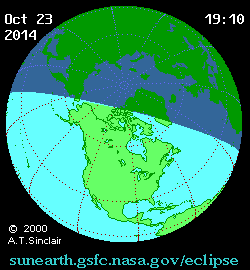(Newswire.net — October 23, 2014) — North America will have a ringside seat to the partial eclipse of the sun on October 23, 2014 which will be almost exclusively visible to viewers in North America.
The moon will clip the visible disc of the sun, making it look like some one took a bite out of it. The event will reach its height at 5:45 p.m. ET. Observers living in the central U.S. will get the best view; New England and Hawaii will miss out entirely.
Eye safety protocol is of the utmost importance if you want to watch the eclipse directly. Be warned, standard sunglasses are not enough to ensure eye safety.
 A lunar eclipse happens whenever the new moon passes in front of the sun, and cast a shadow on our planet. A solar eclipse is only possible at new moon because that’s the only time whereby the moon can go in front of the sun, as seen from Earth.
A lunar eclipse happens whenever the new moon passes in front of the sun, and cast a shadow on our planet. A solar eclipse is only possible at new moon because that’s the only time whereby the moon can go in front of the sun, as seen from Earth.
Most of the time, however, the new moon either moves north or
south of the solar disk, so no eclipse of the sun takes place.
The plane of the moon’s orbit around Earth is inclined at 5 degrees to the plane of the Earth’s orbit around the sun.
Half each month, the moon orbits Earth to the north of the Earth’s orbital plane, for the other half of the month, the moon orbits Earth to the south of the ecliptic. Twice a month, however, the moon crosses the Earth’s orbital plane at points called nodes.
When the moon is traveling from north to south, it’s called a descending node, and vice versa, when it’s going from south to north, we call it an ascending node.
A solar eclipse is not only possible – but inevitable when the (new) moon is at or near one of its nodes.
It’s far from a perfect alignment this time around, though, as the moon reaches its ascending node about 21 hours before the moon turns new.
Thereby, the moon’s dark umbrella-like shadow misses Earth completely, falling some 420 miles above the Earth’s surface.
Although no total solar eclipse can be seen from Earth, the new moon happens close enough to its ascending node for the moon’s penumbral shadow to fall on Earth and for a partial solar eclipse to take place at northerly latitudes.